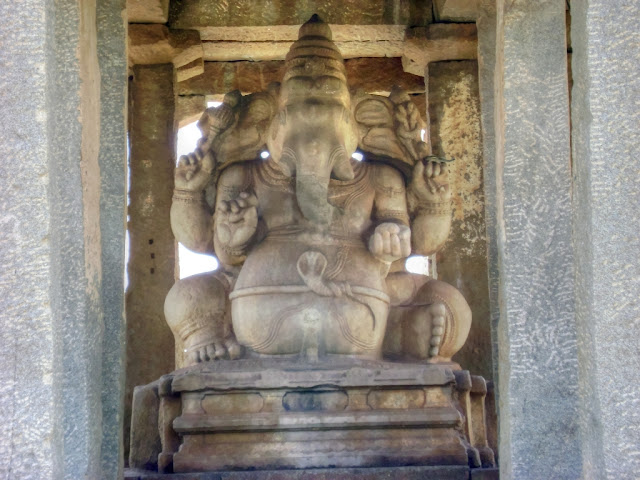Hemakunta Hill is an ancient fortified region from Viayanagara and Pre-Vijayanagara period. It was was once
secured with surrounding walls and gateways. The Hemakunta Hill
temples in Hampi consist of a large number of temples located on a rocky and uneven terrain.
Once we exit the Virupaksha temple and take an immediate
right, one can see the flight of steps leading to the Hemakunta hill
temples in Hampi. These temples are a must see attraction during the Hampi tour.
History of the Hemakunta hill temples in Hampi
Hemakunta hill has an interesting story associated with it.
A local girl named Pampa, fell in love with the snake clad, ash covered sage
doing penance on the hill. His name was Shiva, the most ferocious of the holy
trinity accounted by the Vedic scriptures. Shiva initially decided to ignore the
romantic advances by Pampa but story did have a happy ending as Shiva married
Pampa, thus making her the Pampa Devi.
myth says it rained gold at the hill during
this glorious occasion. Hence the hill was named Hema-Kunta meaning the “Bowl
of Gold” in Sanskrit.While doing a Hampi tour, it is great to understand these legends, which will make the visit worthwhile.
On the granite slopes of the Hemakunta hill, around 35
ancient temples are located. There are a few structures which deserves a
special mention. One of them is a north facing temple with pyramidal roof
which reminds us of the Jain architecture.
The Kampila shrine: Most ancient temple among Hemakunta hill temples in Hampi
An inscribed slab in this temple mentions that it was built by Kampila in the 14
th century. Kampila is
the predecessor of the Vijayanagara rulers who was the king of a small kingdom in the Thungabadra valley till 1327. It is one of the oldest Hampi temples.
The Jain temples : Hemakunta Hill temples in Hampi built in Rastrakuta style
There is a group of Hampi temples on Hemakunta hill that are generally known
as the Jain temples due to the resemblance of its multi storied towers. However,
these temples are actually built in the typical
Rastrakuta style.
Most of the Hampi temples in the Hemakunta hill houses Shiva in Linga form as their deity, which has made the experts believe that it was a fortified complex which was built in the Shyva religious cult.
The original Virupaksha temple ( the core / “Moola Virupaksha”) is believed to be located at the Hemakunta hill. Experts suggests that there was a stone path that connected this core VIrupaksha temple with the present day Virupaksha temple. The path started at the summit of the Hill, passed through multiple gateways, passed through the Manmatha tank and ended in the Virupaksha temple. However, as Krishnadevaraya renovated the present day Virupaksha temple, this path was cut off. However, The reminiscent of these gateways still exist.
From the above gateway, one can have a breath taking view of
the Thungabadra valley, especially during the sun rise and the sun set.
The Sasivekalu Ganesha temple in Hampi
A temple in Hampi that houses the Sasivekalu Ganesha sculpture
is located near the Hemakunta group of temples. Sasive(ಸಾಸಿವೆ) in Kannada means mustard seed and
it appears that the Ganesha statue resemble a mustard seed made of stone! The 2.4 meters high statue is placed under
a roof, supported by pillars with a relatively simple carvings.
Legend behind the Sasivekalu Ganesha temple in Hampi
The myth behind this statue goes
like this -
Lord Ganesha is a complete
foodie and once he ate too much of Modaka(a kind of sweet rice cake) and he was
afraid that his tummy would burst! ( Happens with any foodie. Right? ) . The
cute Ganesha was not short of ideas to save his tummy, so he took a snake that
passed by and tied it around his waist. Tada! The problem solved.
According to inscriptions found nearby this pavilion was
built by a trader from Chandragiri (in present day Andhra Pradesh)in 1506 AD,
in memory of one of the Vijayanagara king – Narasimha II (1491-1505 AD)
TheKadalekalu Ganesha Temple in Hampi
Another temple in Hampi worth visiting near
the Hemakunta hills is the Kadalekalu Ganesha temple. The person who had
named these sculptures must have had a great
imagination for, Kadale in Kannada means “Bengal gram”. The idol is not
directly visible from outside, as the inner sanctum is covered by a pillared
Mantapa (Hall) in front of it. There are 24 pillars which look extremely
slender and grim without any curves.
As we enter through the Mantapa
and walk towards the inner sanctum, we can see a 4.5 feet Ganesha idol, which
is carved out of single, natural boulder. Like the mustard seed shaped Ganesha
statue(Sasivekalu Ganesh), the idol in the Kadalekalu Ganesh also had a huge
round tummy. However, this time Ganesha seemed to be careful about how much he
ate, as his tummy looked perfectly fine.
However,
on a close observation, we can see that the
trunk of Ganesha is reaching towards the Modak (the sweet rice cake) in his
left hand, suggesting that his meal is not yet over.













A4704246F2
ReplyDeletekiralık hacker
hacker arıyorum
belek
kadriye
serik
B9479C47B6
ReplyDeleteTakipçi Satın Al
M3u Listesi
Telegram Coin Botları
Osm Promosyon Kodu
Viking Rise Hediye Kodu
3F256D281E
ReplyDeleteen uygun instagram takipçi
swivel rocker accent chair
EE0AE3B09E
ReplyDeleteTakipçi Satın Al
YT Ücretsiz Abone
Viski Fiyatları
Post a Comment